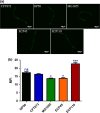Virulence behavior of uropathogenic Escherichia coli strains in the host model Caenorhabditis elegans
- PMID: 30381890
- PMCID: PMC6562141
- DOI: 10.1002/mbo3.756
Virulence behavior of uropathogenic Escherichia coli strains in the host model Caenorhabditis elegans
Abstract
Urinary tract infections (UTIs) are among the most common bacterial infections in humans. Although a number of bacteria can cause UTIs, most cases are due to infection by uropathogenic Escherichia coli (UPEC). UPEC are a genetically heterogeneous group that exhibit several virulence factors associated with colonization and persistence of bacteria in the urinary tract. Caenorhabditis elegans is a tiny, free-living nematode found worldwide. Because many biological pathways are conserved in C. elegans and humans, the nematode has been increasingly used as a model organism to study virulence mechanisms of microbial infections and innate immunity. The virulence of UPEC strains, characterized for antimicrobial resistance, pathogenicity-related genes associated with virulence and phylogenetic group belonging was evaluated by measuring the survival of C. elegans exposed to pure cultures of these strains. Our results showed that urinary strains can kill the nematode and that the clinical isolate ECP110 was able to efficiently colonize the gut and to inhibit the host oxidative response to infection. Our data support that C. elegans, a free-living nematode found worldwide, could serve as an in vivo model to distinguish, among uropathogenic E. coli, different virulence behavior.
Keywords: Caenorhabditis elegans; Escherichia coli; oxidative stress; urinary tract infections; uropathogenic strains.
© 2018 The Authors. MicrobiologyOpen published by John Wiley & Sons Ltd.
Conflict of interest statement
The authors declare no conflict of interest.
Figures






References
-
- Anastasi, E. M. , Matthews, B. , Gundogdu, A. , Vollmerhausen, T. L. , Ramos, N. L. , Stratton, H. , … Katouli, M. (2010). Prevalence and persistence of Escherichia coli strains with uropathogenic virulence characteristics in sewage treatment plants. Applied and Environmental Microbiology, 76, 5882–5886. 10.1128/AEM.00141-10 - DOI - PMC - PubMed
-
- Anyanful, A. , Dolan‐Livengood, J. M. , Lewis, T. , Sheth, S. , Dezalia, M. N. , Sherman, M. A. , … Kalman, D. (2005). Paralysis and killing of Caenorhabditis elegans by enteropathogenic Escherichia coli requires the bacterial tryptophanase gene. Molecular Microbiology, 57, 988–1007. 10.1111/j.1365-2958.2005.04739.x - DOI - PubMed
Publication types
MeSH terms
Substances
Associated data
- Actions
- Actions
- Actions
- Actions
- Actions
- Actions
- Actions
- Actions
- Actions
Grants and funding
LinkOut - more resources
Full Text Sources
Medical

